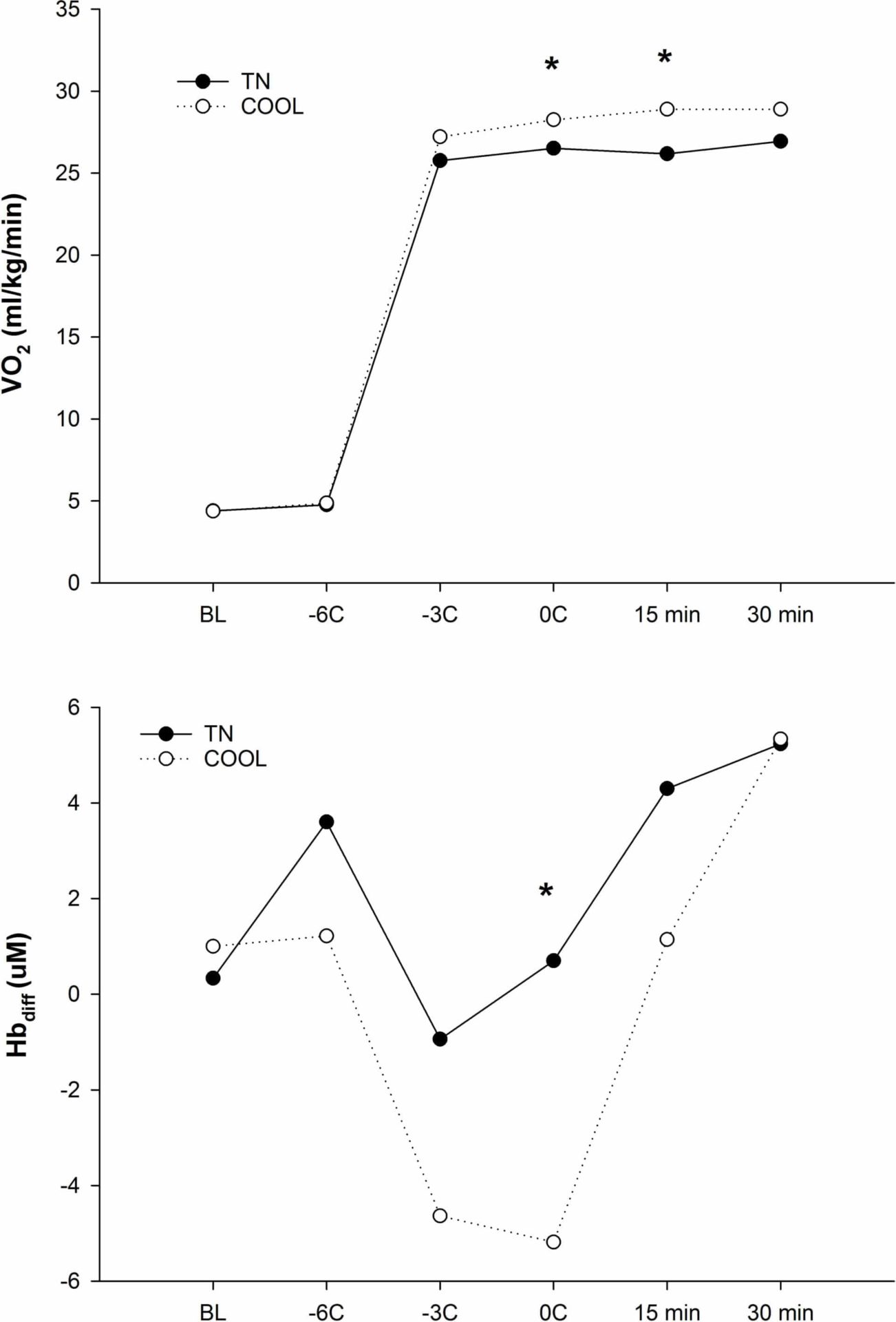Muscle cooling has been associated with reduced physical performance due to increased O2 consumption requirements, reduced mechanical efficiency, altered neuromuscular functions, blood volume, and O2 extraction (Oksa et al., 2002; Gagnon et al., 2017). Whether these factors influence the skeletal muscle deoxygenation response, and consequently metabolism, during physical performance, is unclear. This study investigated skeletal muscle oxidative responses, metabolism, and cardiovascular hemodynamics during cycling at a fixed workload following muscle cooling. Seven healthy participants (26 ± 5.7 years, 174 ± 8.8 cm, 75 ± 13.1 kg, 21 ± 3.4%BF, 49 ± 8.7 VO2peak) dressed in shorts and a t-shirt, performed two steady-state exercise sessions at 70% of ventilatory threshold (VT), on a cycle ergometer, in a fasted state. Sessions were conducted in a thermoneutral environment (22.0°C), with (LCO) and without (CON) a pre-exercise leg-cooling protocol in 10°C water until muscle temperature (Tm) decreased by 6°C. Exercise was then initiated at 70%VT until Tm returned to baseline. Cycling continued for another 30 min. Cardiorespiratory and metabolic variables were assessed via indirect calorimetry, whereas skeletal muscle tissue oxygenation (%TSI) and the difference in oxygenated and deoxygenated hemoglobin content (diffHb) were assessed with near-infrared spectroscopy (NIRS). Cardiovascular hemodynamic responses were collected via intrathoracic bioimpedence. Venous blood samples were collected to assess changes in lactate, pH, pO2 and pCO2. Two-way ANOVA were used (conditions and times) to assess differences with a level of significance set at p<0.05. HR, SV, and CO all increased across time but were not different between conditions. VO2 was greater in LCO vs. CON when muscle temperature was restored (28 ± 2 vs. 26 ± 3 mlO2/kg/min; p<0.05), and at 15 min of exercise (29 ± 4 vs. 26 ± 3 mlO2/kg/min; p<0.05). %TSI was higher at the onset of exercise (58 ± 5%) compared when muscle temperature was restored (49 ± 5%; p<0.001) and at 15 min of exercise (53 ± 7 %; p<0.001) but no differences were observed between conditions. While diffHb followed the same trend, it was also lower in LCO vs. TN when muscle temperature was restored (-5.2 ± 5 vs. 1 ± 2 µM; p<0.05). Blood pH, pO2 were lower while pCO2 was higher when muscle temperature was restored in the LCO condition but at no other point in time (p<0.05). The present study demonstrates an increase in oxygen consumption from pre-exercise muscle cooling, associated with lower tissue oxygenation despite the return of muscle temperature to baseline values. A delayed metabolic response could explain the present results. Nonetheless, whether the increase in oxygen demand drives additional O2 uptake, or, the lower O2 availability drives a greater energy demand, remains to be determined.
Physiology 2019 (Aberdeen, UK) (2019) Proc Physiol Soc 43, PC098
Poster Communications: The influences of skeletal muscle temperature on muscle deoxygenation and metabolism at fixed exercise workload
D. Gagnon1,2, S. Munten1
1. Human Kinetics, Laurentian University, Sudbury, Ontario, Canada. 2. Center for Research in Occupational Safety and Health, Laurentian University, Sudbury, Ontario, Canada.
View other abstracts by:
Where applicable, experiments conform with Society ethical requirements.

